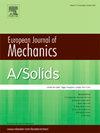Phase field study on the temperature dependence of the shape memory effect and superelasticity of NiTi alloys with different grain sizes
IF 4.4
2区 工程技术
Q1 MECHANICS
引用次数: 0
Abstract
The shape memory effect (SME) and superelasticity (SE) of NiTi shape memory alloys (SMAs) were reported to be severely affected by grain size (GS) and temperature. The effect of temperature on the GS-dependent SME and SE of polycrystalline NiTi SMAs and underlying mechanisms have not yet been comprehensively understood. In this work, a new diffuse grain boundary energy related to the misorientation among adjacent grains is introduced into the phase field model. The effect of temperature on the GS-dependent SME and SE of nanocrystalline and polycrystalline NiTi SMAs is studied by systematic phase field simulations. It turns out that both the critical GSs for twinned martensite nucleation and the termination of twinned martensite propagation increase with increasing the temperature since the internal stress field (decreases with decreasing the GS) gradually becomes unable to break through the hindrance of both the grain boundary energy (increases with decreasing the GS) and the energy barrier (increases with increasing the temperature) on the martensite transformation in nanocrystalline NiTi SMAs. After the SME and SE processes, the residual strain in the alloys increases with increasing the GS because the (deformation incompatibility dependent) stress field is insufficient to prompt a complete reverse martensite transformation when the GS is relatively large. This phenomenon can be relieved by increasing the temperature (due to the reduced energy barrier).
求助全文
约1分钟内获得全文
求助全文
来源期刊
CiteScore
7.00
自引率
7.30%
发文量
275
审稿时长
48 days
期刊介绍:
The European Journal of Mechanics endash; A/Solids continues to publish articles in English in all areas of Solid Mechanics from the physical and mathematical basis to materials engineering, technological applications and methods of modern computational mechanics, both pure and applied research.

 求助内容:
求助内容: 应助结果提醒方式:
应助结果提醒方式:


